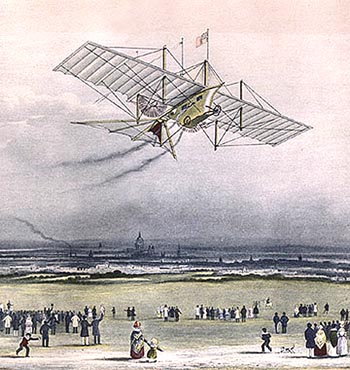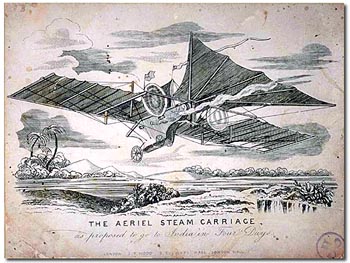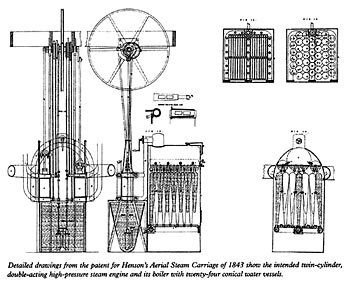
John Stringfellow (1799 - 1883)William Henson (1812 - 1888)
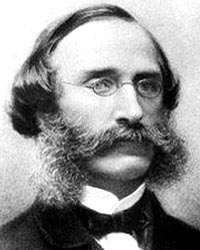 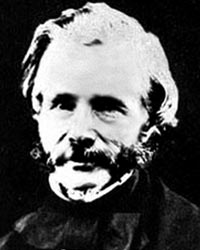 William Samuel Henson and John Stringfellow
Henson and Stringfellow: The Dream Takes Shape http://www.esparacing.com Born in 1812, William Samuel Henson was, like his father, a successful industrialist in the lacemaking business in Somerset, England. In 1840, under the influence of Cayley's early writings, Henson and an engineer who also worked in the lacemaking industry, John Stringfellow, designed a steam-driven airplane they called an "aerial steam carriage." There were many elements of the design of the Ariel (as Henson called it) that proved to be prophetic of later aircraft, and a simple glance at the design makes one feel as if one is looking at a cartoon prototype of the modern airliner. In fact, Henson and Stringfellow planned to create an international airline, the Aerial Transit Company, and proceeded to raise investment capital. They embarked on a massive publicity campaign that involved illustrations of the Ariel in flight over London and exotic settings in Egypt, India, and China. They hoped that the illustrations would make people believe the aircraft was an established fact. ...more
A History of Aeronautics, Chap. IV., Henson and Stringfellow by E. Charles Vivian Cayley had shown, in 1809, how success might be attained by developing the idea of the plane surface so driven as to take advantage of the resistance offered by the air, and Henson, who as early as 1840 was experimenting with model gliders and light steam engines, evolved and patented an idea for something very nearly resembling the monoplane of the early twentieth century.
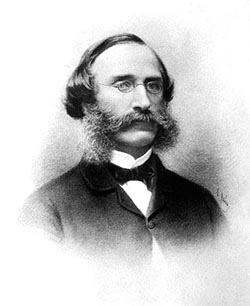 William Samuel Henson download a 500pixel image
His patent, No. 9478, of the year 1842 explains the principle of the machine as follows:--
In order that the description hereafter given be rendered clear, I will first shortly explain the principle on which the machine is constructed.The machine in question was very large, and differed very little from the modern monoplane; the materials were to be spars of bamboo and hollow wood, with diagonal wire bracing. The surface of the planes was to amount to 4,500 square feet, and the tail, triangular in form (here modern practice diverges) was to be 1,500 square feet. The inventor estimated that there would be a sustaining power of half a pound per square foot, and the driving power was to be supplied by a steam engine of 25 to 30 horse-power, driving two six-bladed propellers. Henson was largely dependent on Stringfellow for many details of his design, more especially with regard to the construction of the engine. The publication of the patent attracted a great amount of public attention, and the illustrations in contemporary journals, representing the machine flying over the pyramids and the Channel, anticipated fact by sixty years and more; the scientific world was divided, as it was up to the actual accomplishment of flight, as to the value of the invention. Stringfellow and Henson became associated after the conception of their design, with an attorney named Colombine, and a Mr Marriott, and between the four of them a project grew for putting the whole thing on a commercial basis--Henson and Stringfellow were to supply the idea; Marriott, knowing a member of Parliament, would be useful in getting a company incorporated, and Colombine would look after the purely legal side of the business. Thus an application was made by Mr Roebuck, Marriott's M.P., for an act of incorporation for 'The Aerial Steam Transit Company,' Roebuck moving to bring in the bill on the 24th of March, 1843. The prospectus, calling for funds for the development of the invention, makes interesting reading at this stage of aeronautical development; it was as follows: PROPOSAL.
For subscriptions of sums of L100, in furtherance of an Extraordinary Invention not at present safe to be developed by securing the necessary Patents, for which three times the sum advanced, namely, L300, is conditionally guaranteed for each subscription on February 1, 1844, in case of the anticipations being realised, with the option of the subscribers being shareholders for the large amount if so desired, but not otherwise.The applications did not materialise, as was only to be expected in view of the vagueness of the proposals. Colombine did some advertising, and Mr Roebuck expressed himself as unwilling to proceed further in the venture. Henson experimented with models to a certain extent, while Stringfellow looked for funds for the construction of a full-sized monoplane. In November of 1843 he suggested that he and Henson should construct a large model out of their own funds. On Henson's suggestion Colombine and Marriott were bought out as regards the original patent, and Stringfellow and Henson entered into an agreement and set to work.
Their work is briefly described in a little pamphlet by F. J. Stringfellow, entitled A few Remarks on what has been done with screw-propelled Aero-plane Machines from 1809 to 1892. The author writes with regard to the work that his father and Henson undertook:-- 'They commenced the construction of a small model operated by a spring, and laid down the larger model 20 ft. from tip to tip of planes, 3 1/2 ft. wide, giving 70 ft. of sustaining surface, about 10 more in the tail. The making of this model required great consideration; various supports for the wings were tried, so as to combine lightness with firmness, strength and rigidity. 'The planes were staid from three sets of fish-shaped masts, and rigged square and firm by flat steel rigging. The engine and boiler were put in the car to drive two screw-propellers, right and left-handed, 3 ft. in diameter, with four blades each, occupying three-quarters of the area of the circumference, set at an angle of 60 degrees.In the meantime an engine was also made for the smaller model, and a wing action tried, but with poor results. The time was mostly devoted to the larger model, and in 1847 a tent was erected on Bala Down, about two miles from Chard, and the model taken up one night by the workmen. The experiments were not so favourable as was expected. The machine could not support itself for any distance, but, when launched off, gradually descended, although the power and surface should have been ample; indeed, according to latest calculations, the thrust should have carried more than three times the weight, for there was a thrust of 5 lbs. from the propellers, and a surface of over 70 square feet to sustain under 30 lbs., but necessary speed was lacking.
Stringfellow himself explained the failure as follows:-- 'There stood our aerial protegee in all her purity--too delicate, too fragile, too beautiful for this rough world; at least those were my ideas at the time, but little did I think how soon it was to be realised. I soon found, before I had time to introduce the spark, a drooping in the wings, a flagging in all the parts. In less than ten minutes the machine was saturated with wet from a deposit of dew, so that anything like a trial was impossible by night. I did not consider we could get the silk tight and rigid enough. Indeed, the framework altogether was too weak. The steam-engine was the best part. Our want of success was not for want of power or sustaining surface, but for want of proper adaptation of the means to the end of the various parts.'Henson, who had spent a considerable amount of money in these experimental constructions, consoled himself for failure by venturing into matrimony; in 1849 he went to America, leaving Stringfellow to continue experimenting alone. From 1846 to 1848 Stringfellow worked on what is really an epoch-making item in the history of aeronautics--the first engine-driven aeroplane which actually flew.
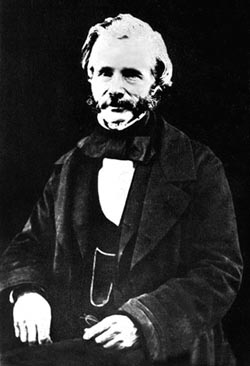 John Stringfellow download a 500pixel image
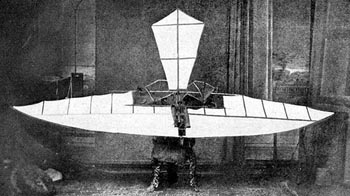 John Stringfellow, monoplane, 1848 download a 1000pixel image
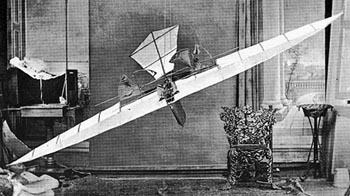 John Stringfellow, monoplane, 1848
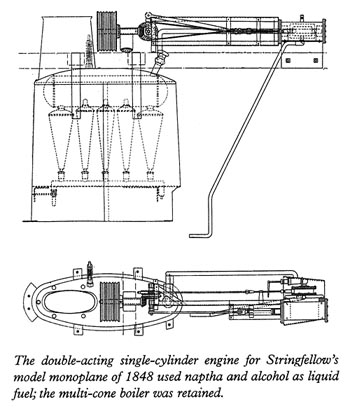 John Stringfellow, engine, 1848 download a 1000pixel image
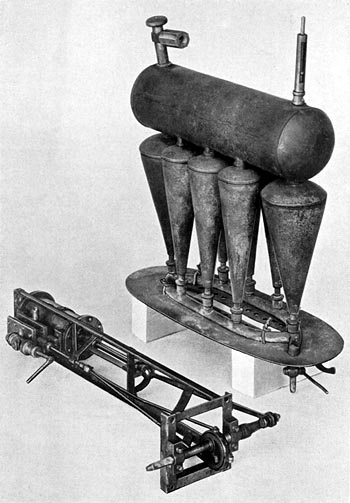 John Stringfellow, engine, 1848 download a 1000pixel image
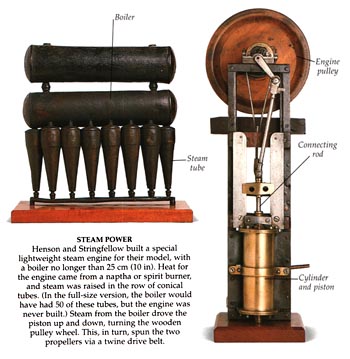 John Stringfellow, engine, 1848 Science Museum, London. Photo : Dorling Kindersley download a 1000pixel image
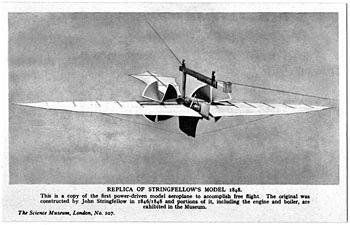 John Stringfellow, 1848, modern replica, post card Science Museum, London. download a 1000pixel image
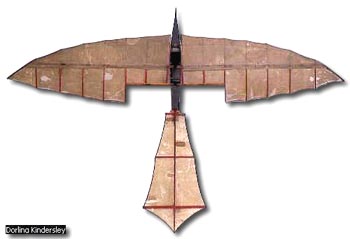 John Stringfellow, monoplane, 1848 Science Museum, London. Photo : Dorling Kindersley
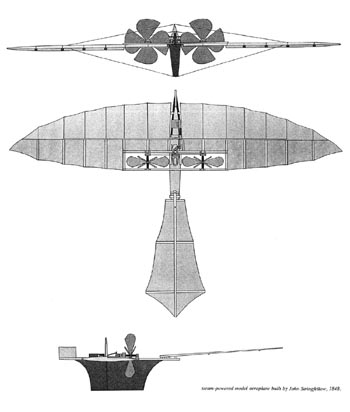 John Stringfellow, monoplane, 3view, 1848 download a 1000pixel or 1500pixel image
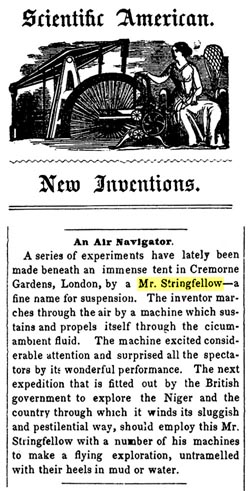
Scientific American. Volume 4, Issue 1, p.4 http://cdl.library.cornell.edu download a 500pixel image
The machine in question had a 10 foot span, and was 2 ft. across in the widest part of the wing; the length of tail was 3 ft. 6 ins., and the span of tail in the widest part 22 ins., the total sustaining area being about 14 sq. ft. The motive power consisted of an engine with a cylinder of three-quarter inch diameter and a two-inch stroke; between this and the crank shaft was a bevelled gear giving three revolutions of the propellers to every stroke of the engine; the propellers, right and left screw, were four-bladed and 16 inches in diameter. The total weight of the model with engine was 8 lbs. Its successful flight is ascribed to the fact that Stringfellow curved the wings, giving them rigid front edges and flexible trailing edges, as suggested long before both by Da Vinci and Borelli, but never before put into practice. Mr F. J. Stringfellow, in the pamphlet quoted above, gives the best account of the flight of this model:
'My father had constructed another small model which was finished early in 1848, and having the loan of a long room in a disused lace factory, early in June the small model was moved there for experiments. The room was about 22 yards long and from 10 to 12 ft. high.... The inclined wire for starting the machine occupied less than half the length of the room and left space at the end for the machine to clear the floor. In the first experiment the tail was set at too high an angle, and the machine rose too rapidly on leaving the wire. After going a few yards it slid back as if coming down an inclined plane, at such an angle that the point of the tail struck the ground and was broken. The tail was repaired and set at a smaller angle. The steam was again got up, and the machine started down the wire, and, upon reaching the point of self-detachment, it gradually rose until it reached the farther end of the room, striking a hole in the canvas placed to stop it. In experiments the machine flew well, when rising as much as one in seven. The late Rev. J. Riste, Esq., lace manufacturer, Northcote Spicer, Esq., J. Toms, Esq., and others witnessed experiments. Mr Marriatt, late of the San Francisco News Letter brought down from London Mr Ellis, the then lessee of Cremorne Gardens, Mr Partridge, and Lieutenant Gale, the aeronaut, to witness experiments. Mr Ellis offered to construct a covered way at Cremorne for experiments. Mr Stringfellow repaired to Cremorne, but not much better accommodations than he had at home were provided, owing to unfulfilled engagement as to room. Mr Stringfellow was preparing for departure when a party of gentlemen unconnected with the Gardens begged to see an experiment, and finding them able to appreciate his endeavours, he got up steam and started the model down the wire. When it arrived at the spot where it should leave the wire it appeared to meet with some obstruction, and threatened to come to the ground, but it soon recovered itself and darted off in as fair a flight as it was possible to make at a distance of about 40 yards, where it was stopped by the canvas. Having now demonstrated the practicability of making a steam-engine fly, and finding nothing but a pecuniary loss and little honour, this experimenter rested for a long time, satisfied with what he had effected. The subject, however, had to him special charms, and he still contemplated the renewal of his experiments.'It appears that Stringfellow's interest did not revive sufficiently for the continuance of the experiments until the founding of the Aeronautical Society of Great Britain in 1866. Wenham's paper on Aerial Locomotion read at the first meeting of the Society, which was held at the Society of Arts under the Presidency of the Duke of Argyll, was the means of bringing Stringfellow back into the field. It was Wenham's suggestion, in the first place, that monoplane design should be abandoned for the superposition of planes; acting on this suggestion Stringfellow constructed a model triplane, and also designed a steam engine of slightly over one horse-power, and a one horse-power copper boiler and fire box which, although capable of sustaining a pressure of 500 lbs. to the square inch, weighed only about 40 lbs.
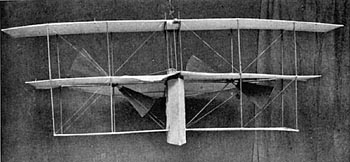 John Stringfellow, Triplane, 1868
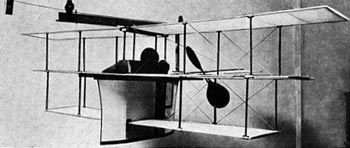 John Stringfellow, Triplane, 1868
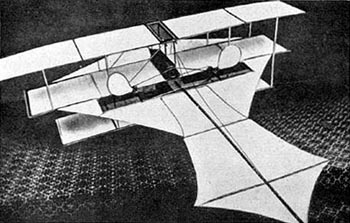 John Stringfellow, Triplane, 1868
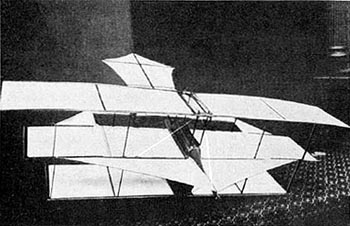 John Stringfellow, Triplane, 1868
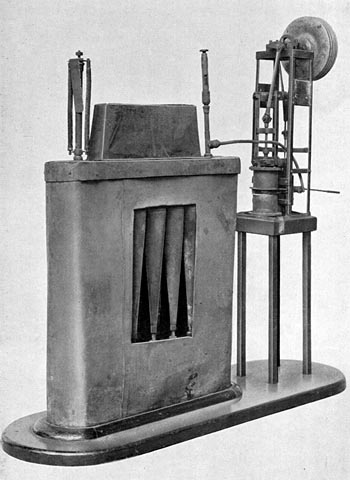 John Stringfellow, engine, 1848 download a 1000pixel image
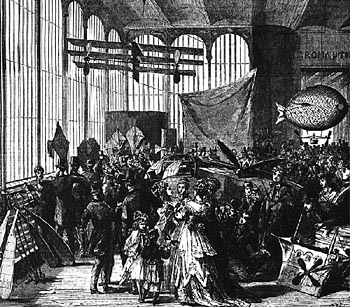
John Stringfellow Triplane
W.J. Jackman and Thos. H. Russell, Flying Machines: Construction and Operation

Scientific American. / New Series, Volume 20, Issue 11, p.69 http://cdl.library.cornell.edu download a 500pixel image
Both the engine and the triplane model were exhibited at the first Aeronautical Exhibition held at the Crystal Palace in 1868. The triplane had a supporting surface of 28 sq. ft.; inclusive of engine, boiler, fuel, and water its total weight was under 12 lbs. The engine worked two 21 in. propellers at 600 revolutions per minute, and developed 100 lbs. steam pressure in five minutes, yielding one-third horse-power. Since no free flight was allowed in the Exhibition, owing to danger from fire, the triplane was suspended from a wire in the nave of the building, and it was noted that, when running along the wire, the model made a perceptible lift. A prize of L100 was awarded to the steam engine as the lightest steam engine in proportion to its power. The engine and model together may be reckoned as Stringfellow's best achievement. He used his L100 in preparation for further experiments, but he was now an old man, and his work was practically done. Both the triplane and the engine were eventually bought for the Washington Museum; Stringfellow's earlier models, together with those constructed by him in conjunction with Henson, remain in this country in the Victoria and Albert Museum. John Stringfellow died on December 13th, 1883. His place in the history of aeronautics is at least equal to that of Cayley, and it may be said that he laid the foundation of such work as was subsequently accomplished by Maxim, Langley, and their fellows. It was the coming of the internal combustion engine that rendered flight practicable, and had this prime mover been available in John Stringfellow's day the Wright brothers' achievement might have been antedated by half a century.
|
© Copyright 1999-2002 CTIE - All Rights Reserved - Caution |
